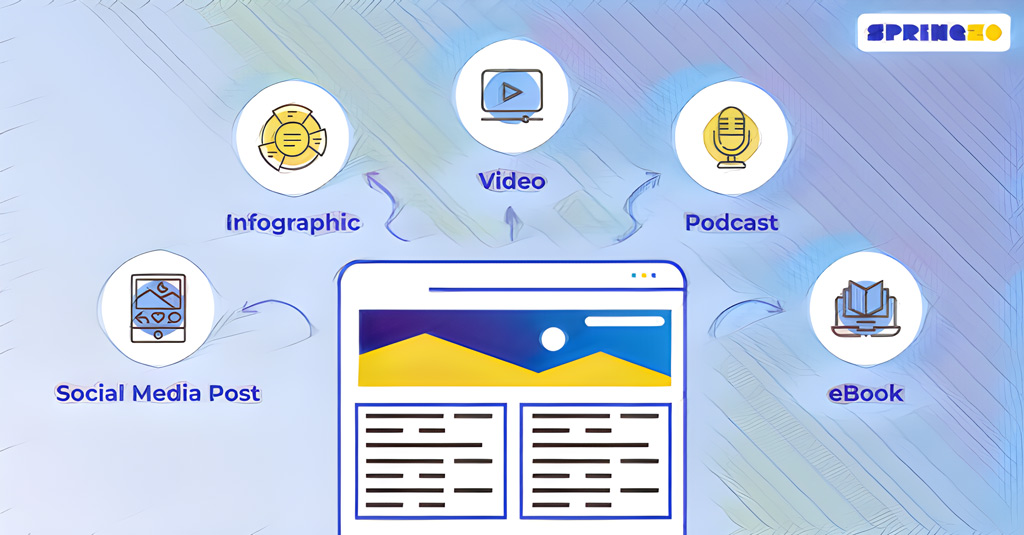As a brand, it becomes critical to find your distinct voice by delivering content that users deem helpful. However, creating this from scratch can be an arduous and time-consuming endeavor. Fortunately, brands can tap into their existing repository and leverage content repurpose ideas to achieve high-quality material in a shorter time frame and with less effort.
In fact, according to recent studies, companies that repurpose their content report a 72% increase in engagement and a 62% increase in leads generated.
In this blog post, we will explore the art of content repurposing and discuss effective strategies to optimize your content. So, let’s dive right into it.
What is Content Repurposing?
Content repurpose generally involves taking existing content and transforming it into various formats or using it in a different context to reach a wider audience and maximize its value.
By repurposing, you can extend its lifespan, save time in production, align content with your core brand values, increase visibility, and eventually generate more leads. Additionally, by leveraging content repurposing strategies, you can reduce the need to come up with new ideas constantly.
In fact, a recent survey revealed that 65% of marketers considered content repurposing as the most cost-effective strategy in their marketing efforts.
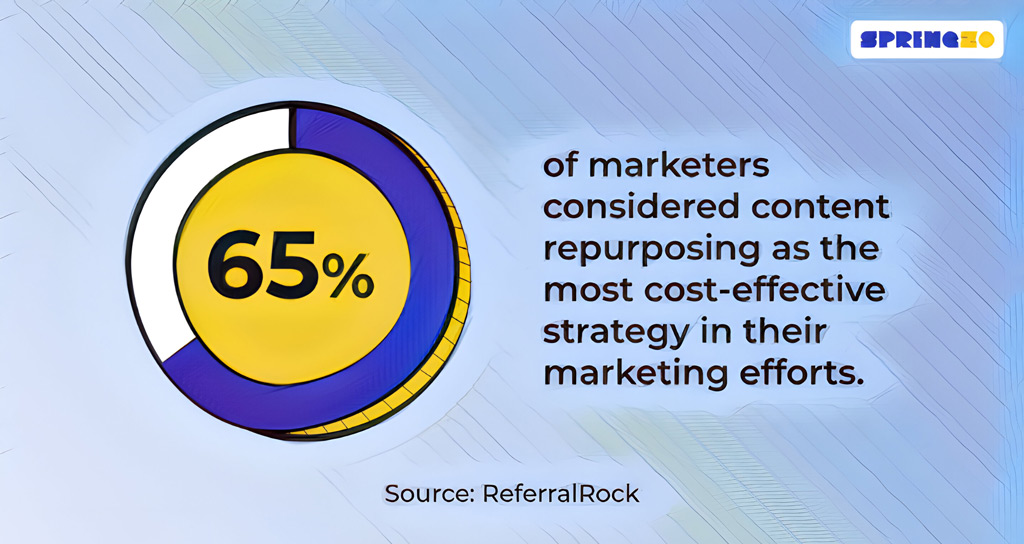
It’s a smart and efficient way to make the most out of your hard work, ensuring that your content continues to deliver results long after its initial creation.
What Is NOT Content Repurposing?
Content repurposing is not just reusing and reposting the same material. It means adapting and redefining your existing content creatively for different platforms and audiences.
Avoid sounding repetitive and promotional all the time. Repurposing should offer new value and not simply edit and repackage old content. It’s about being imaginative and reaching wider audiences by transforming your content for various formats.
Maximizing Impact: The Benefits of Content Repurposing
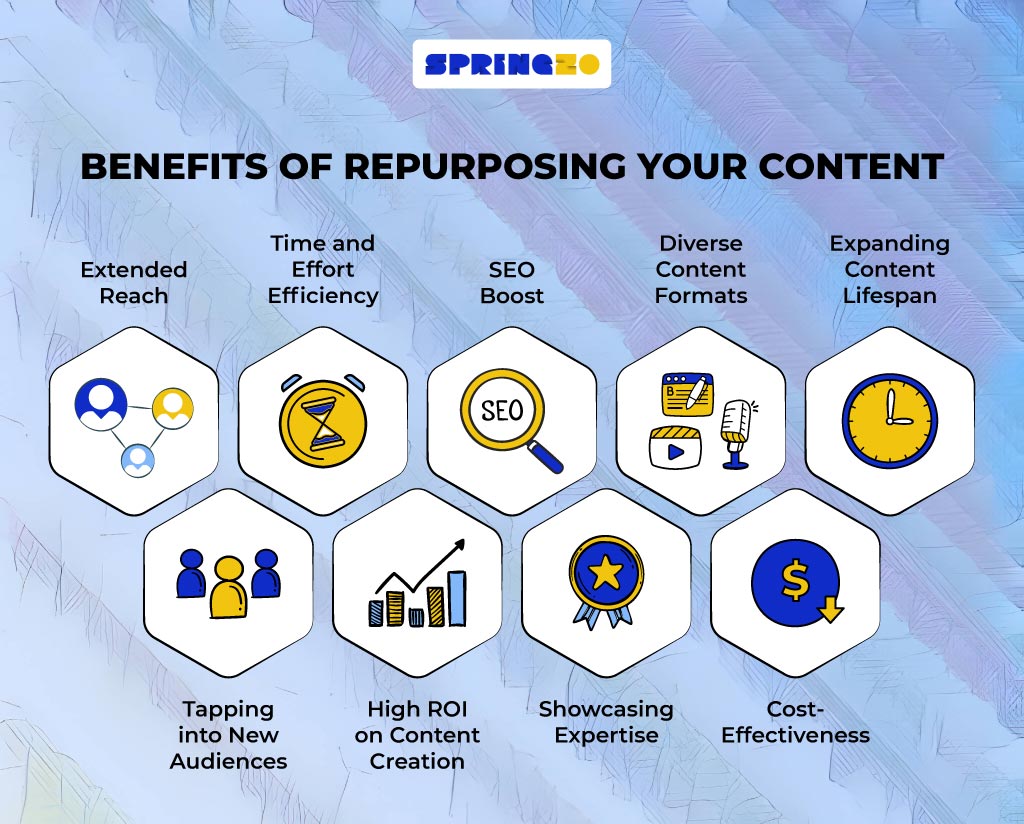
Repurposing content is a valuable strategy in content marketing and has numerous benefits. Below, we’ve outlined the reasons why you should consider repurposing your content:
1. Extended Reach
By repurposing content, you can cater to different audience segments across various platforms. Some people prefer reading blog posts, while others enjoy watching videos or listening to podcasts. It also allows you to connect with your audience on their preferred channels, thus expanding your reach.
2. Time and Effort Efficiency
Creating high-quality content takes time and effort. Repurposing enables you to leverage your initial investment and save valuable resources. Instead of starting from scratch, you can modify existing content to suit different purposes, speeding up the content creation process.
3. SEO Boost
Search engines value fresh content, but that doesn’t mean you can’t optimize older content. When you repurpose and update existing pieces, search engines recognize them as relevant and up-to-date, potentially improving your SEO rankings.
4. Diverse Content Formats
Not everyone consumes content in the same way. Repurposing allows you to transform a blog post into an infographic, a podcast episode into a blog post, or a video into a series of social media snippets. This diversity caters to different learning styles and preferences.
5. Expanding Content Lifespan
Some topics remain relevant over time. By repurposing evergreen content, you can keep it alive and valuable, continually attracting new readers or viewers.
6. Tapping into New Audiences
Different platforms attract diverse audiences. Repurposing content allows you to tap into new markets and demographics who might not have discovered your content otherwise.
7. High ROI on Content Creation
Repurposing content allows you to maximize the return on your initial content investment. By transforming existing pieces into new formats, you can generate additional value and reach without incurring significant extra costs.
This improved ROI makes content repurposing a smart and cost-effective strategy for content marketers and businesses.
8. Showcasing Expertise
Repurposing content can position you as an authority in your field. As your content reaches a broader audience, more people recognize your expertise, further enhancing your reputation.
9. Cost-Effectiveness
Creating new content from scratch can be expensive, especially for small businesses or content creators with limited resources. Repurposing content allows you to get more out of your existing assets without significant additional costs.
Which Types of Content Should You Repurpose?
When it comes to repurposing existing content, one of the key types of content that you should consider repurposing is “Anchor/Pillar Content.“
What is Anchor/Pillar Content?
This refers to comprehensive, evergreen pieces of content that serve as the foundation of your content marketing efforts. These pieces are typically long-form, highly informative, and cover a broad topic within your niche.
Anchor content is designed to provide in-depth value to your audience and establish your expertise in the industry.
Examples of Anchor/Pillar content:
- Ultimate Guides: These are comprehensive guides that cover every aspect of a specific topic, providing readers with extensive and valuable information.
- Definitive Case Studies: Detailed case studies that showcase how your product or service has solved a specific problem for a customer, backed up with data and evidence.
- Complete Tutorials: Step-by-step tutorials that guide users through a complex process, helping them achieve a specific outcome.
- Expert Roundups: Curated content featuring insights and opinions from industry experts on a particular subject.
Content Repurposing: From Anchor to Micro
Now that you have your foundational anchor content, the next step is to repurpose it into “Micro Content.“
What is Micro Content?
Micro content refers to bite-sized, easily digestible pieces of content derived from your anchor content. These short-form assets are ideal for sharing on various platforms, captivating your audience’s attention, and driving engagement.
This content allows you to recycle and amplify the value of your anchor content in a more concise and snackable format.
Types of Micro Content with examples:
1. Infographics:
Visual representations of data, statistics, or key points from your anchor content.
Example: An infographic summarizing the main takeaways from your ultimate guide on SEO best practices.
2. Quote Cards:
Eye-catching graphics featuring compelling quotes from your anchor content.
Example: A quote card with an insightful statement from an industry expert interviewed in your whitepaper.
3. Short Videos:
Snippets of video content highlighting essential points or tips from your anchor content.
Example: A 1-minute video showcasing a crucial step from the comprehensive tutorial.
4. Social Media Posts: Short posts or tweets sharing interesting facts or statistics from your anchor content.
Example: A Twitter thread with key findings from your research report.
5. Slide Decks:
Condensed presentations containing the main highlights of your anchor content.
Example: A slide deck summarizing the core concepts from your e-book.
Content Repurposing: 3 Approaches with Examples
Let’s explore three additional ways to repurpose pillar content into micro-content, along with real examples:
1. Podcast Snippets
Convert insightful segments from your anchor content into short audio clips that can be used as teasers or snippets for a podcast series. Podcast snippets are excellent for promoting your longer episodes and enticing listeners to tune in for the full discussion.
Example:
Suppose your anchor content (a long podcast) is a “What is ChatGPT: Heaven or Hell?.” Extract a captivating excerpt from an expert interview discussing the potential impact of AI on various industries and share it as a podcast teaser.
Ref: https://youtu.be/-HkBwSazZsM (Full podcast)
https://youtu.be/Cvk2bhZEvfM (Teaser of the podcast)
(Source: Nikhil Kamath’s YouTube channel)
2. Infographic Summaries
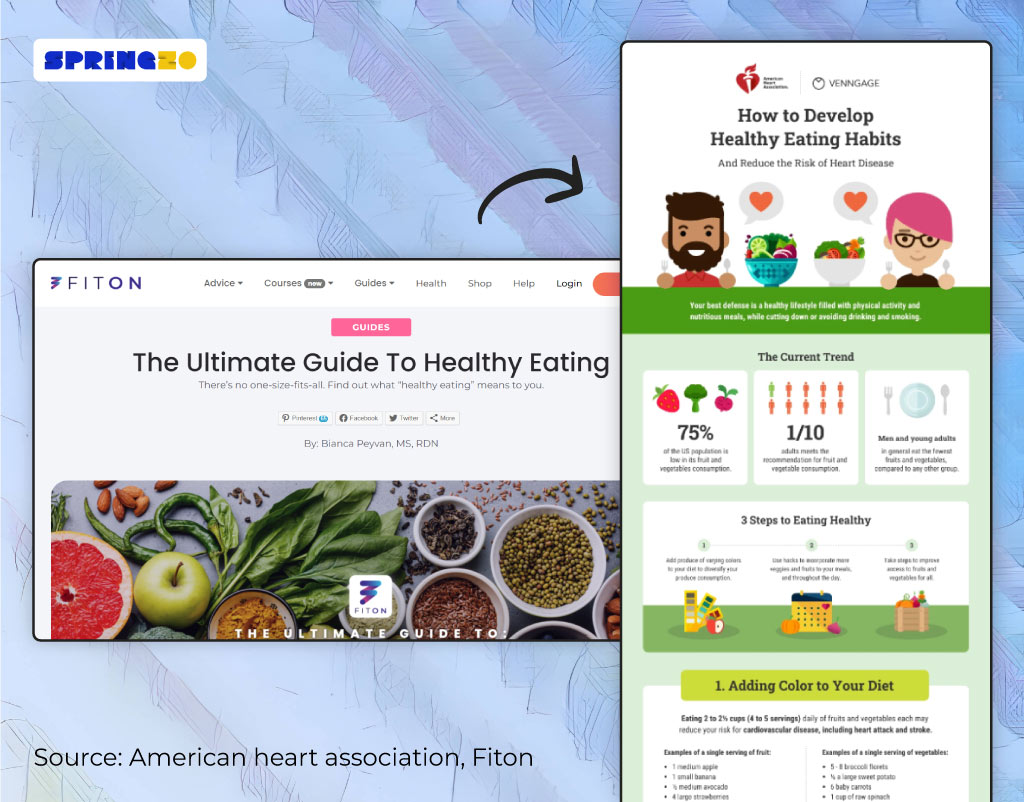
Take the key insights, data, or steps from your pillar content and transform them into visually appealing infographics. Infographics are highly shareable and can quickly convey complex information in an easy-to-understand format.
Example:
Suppose your anchor content is an “Ultimate Guide to Healthy Eating Habits.” You can repurpose it into an infographic that presents the daily recommended food portions for each major food group, along with visual representations of the benefits of maintaining a balanced diet.
3. Email Newsletters
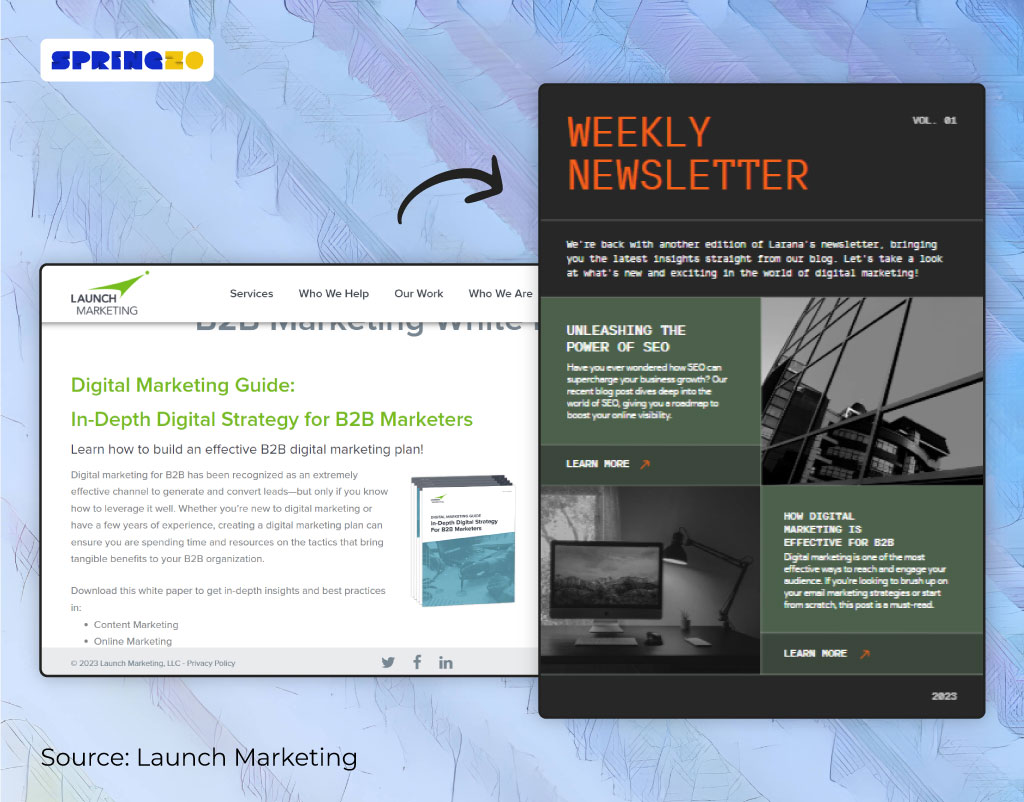
Create engaging email newsletters using snippets from your anchor content. Email is an effective way to reach your audience directly and keep them updated on valuable information while driving traffic back to your website or blog.
Example:
Suppose your anchor content is a “Whitepaper on Digital Marketing Guide for B2B.” Extract some intriguing statistics and trends from the report and use them in your email newsletter to entice subscribers to read the full whitepaper.
Bonus Tip: Don’t forget to include a clear call-to-action (CTA) in your micro-content, directing viewers back to the full anchor/pillar content for further exploration.
Reverse Repurposing: Leveraging Micro Content for In-Depth Content Creation
Now you must be thinking, what is that? Well, reverse repurposing is the process of using micro-content as a starting point to create more substantial and comprehensive pieces of content. This approach allows you to expand on a small piece of content and extract more value from it.
For instance, let’s say you received a glowing testimonial from a satisfied customer praising your web design services for significantly improving their online presence and boosting their sales.
Instead of just using the testimonial as a standalone quote on your website, you can reverse-repurpose it by creating a detailed blog post titled “How Our Web Design Services Transformed a Business’s Online Success.“
Debunking Common Myths About Content Repurposing
While content repurposing offers numerous benefits, there are some common misconceptions that need to be addressed:
1. “Repurposing Means Duplicate Content”
Repurposing is not solely limited to duplicating content across platforms. Rather, it involves the process of adapting, reimagining, and presenting the same core content in various formats tailored to each specific platform or channel. This approach allows content creators to reach different audiences and maximize the value of their original material.
In addition to using repurposed content across various platforms, it can also be utilized on the same channel as long as it is repackaged with a different perspective.
For instance, let’s say you have a well-researched blog post about “Top 10 Ways to Improve Your Productivity.” Instead of copying and pasting the entire blog post onto another platform, you can create an infographic highlighting the key points and share it on social media.
Alternatively, you could turn the same content into a video, where you visually demonstrate each productivity tip. By doing so, you’re not duplicating the exact content but rather repurposing it to suit the visual nature of social media and videos.
2. “Repurposing Diminishes Value”
Content repurposing actually enhances the value of your content by reaching new audiences and maximizing its lifespan. Each format offers a unique experience, catering to different preferences and consumption habits.
For example, you may have an informative podcast episode discussing the latest trends in digital marketing. While some people enjoy listening to podcasts, others prefer reading. By transcribing the podcast and turning it into a blog post, you’re making the content accessible to a broader audience.
3. “Repurposing Is Time-Consuming”
While repurposing does require effort, it can actually save time in the long run. Repurposing allows you to leverage existing content, reducing the need to start from scratch and accelerating the content creation process.
For instance, suppose you’ve conducted a comprehensive research study in the form of a whitepaper on “The Future of E-commerce.” Instead of starting from square one to create a new presentation for a conference, you can repurpose the key findings and data from the whitepaper into compelling slides.
This way, you save time by reusing valuable content and focusing on adapting it to suit the specific presentation format.
Tools and Resources You Can Use for Efficient Content Repurposing
Let’s explore three key categories of tools that can enhance your content repurposing process:
1. Design and Multimedia Creation Tools
Design and multimedia creation tools enable you to create visually appealing assets for your repurposed content. They allow you to design graphics and edit videos to suit different platforms. Here are a few examples:
Tools for Design Graphics
Adobe Illustrator
Adobe Illustrator, the pioneer in vector graphics software, has established the benchmark for creating professional logos, artwork, infographics, icons, and numerous other design elements. It enables you to effortlessly transform a freehand sketch into a scalable vector image, utilizing mathematical formulas rather than pixels, ensuring seamless resizing.
To explore the features of Adobe Illustrator, you can take advantage of a seven-day free trial; however, to begin, a credit card is required. Opting for the annual plan with monthly payments comes at $20.99 (₹ 1,720) per month, whereas the monthly plan costs $31.49 (₹ 2581.88) per month.
Canva
Canva is a versatile platform that allows users to create a wide range of projects, such as infographics, web designs, and newsletters. It features an easy-to-use drag-and-drop interface, making it accessible even for those without prior graphic design experience.
The program provides a vast array of images, templates, backgrounds, and fonts to help users get started. While some of these resources are available for free, certain images and graphics require in-app purchases.
Canva offers three pricing plans, including a free option for individuals and small teams. For individuals, there is Canva Pro, priced at ₹ 3999/year, and for teams, there is Canva for teams, which costs ₹ 6590/year.
Tools for Video Editing:
InVideo
InVideo is an online video editing and creation platform that offers a wide range of features for creating professional-looking videos. It provides a user-friendly interface with a drag-and-drop editor, making it accessible for both beginners and experienced video creators.
InVideo offers a vast library of pre-built templates, stock videos, images, and music, allowing users to quickly create videos for social media, marketing, presentations, and more. With various customization options and easy integration of text and media elements, InVideo enables users to produce high-quality videos efficiently.
It offers a free plan for basic features and watermarked videos. The Business plan, at $15 (₹ 1229) per month, caters to small businesses and educators, providing more tools and watermark-free videos. The Unlimited plan, $30 (₹ 2459) per month, suits agencies and larger teams, offering extensive video creation and collaboration capabilities.
Lumen5
Lumen5 is another online video creation platform, mainly focused on turning text-based content into engaging video content. It uses artificial intelligence and automation to analyze text and automatically generate video scenes that match the content.
Users can input blog posts, articles, or other text sources, and Lumen5 will create video slides with relevant visuals, background music, and text animations. While it offers a more automated approach, users can still customize the generated videos by editing scenes, adding media, and adjusting styles to match their branding.
It comes with four pricing plans. The Basic plan starts at $19 (₹ 1557) per month for essential features, while the Starter plan, $59/mo*, includes more resources for video creation. The Professional plan, $149 (₹ 12216) per month, is designed for advanced users. An Enterprise plan with custom pricing caters to large organizations with specific video needs.
2. Content Management and Scheduling Tools
Content management and scheduling tools allow you to plan, organize, and automate your content repurposing process. They help you stay on top of your content calendar and ensure a consistent flow of repurposed content across various platforms.
Some popular examples include:
Publer
Publer is a social media management tool that allows users to schedule and publish content across various social media platforms. It offers features like multi-platform scheduling, a content calendar, bulk scheduling, and social media analytics.
Publer comes with different pricing tiers: Free, which offers basic features; Professionals at ₹984.24 / $12.00 per month, providing more advanced social media capabilities; and Business, which likely offers additional features suited for larger organizations.
Buffer
Buffer is a popular social media management platform that offers multiple pricing plans to cater to different user needs.
It has a free plan suitable for individuals and businesses starting with social media. For more advanced users, the Essentials plan at $6 (₹ 491) per month offers publishing, analytics, and engagement tools for one channel.
The Team plan at $12 (₹983) per month allows unlimited users, collaboration, and reporting for one channel. Finally, the Agency plan at $120 (₹9838) per month is designed for marketing agencies with 10 or more channels, providing additional features to manage multiple clients.
HubSpot
HubSpot offers a comprehensive CMS software solution to personalize and scale websites.
Its pricing includes the Professional plan starting at $360 (₹29516) per month, providing advanced CMS capabilities for businesses looking to enhance their online presence.
For larger organizations needing more control and flexibility, HubSpot offers the Enterprise plan, starting at $1,200 (₹98388) per month, with additional powerful CMS features and customization options.
3. Analytics and Performance Tracking Tools
When it comes to measuring the success of your repurposed content, utilizing analytics and performance tracking tools becomes crucial. These tools offer valuable insights into various metrics like engagement, reach, and conversions, empowering you to optimize your content repurposing strategy effectively.
In addition to Google Analytics, you may also want to explore the analytics features provided by popular social media platforms such as Facebook, LinkedIn, Twitter, and Instagram.
Each of these platforms offers its own set of post-analytics tools, which can provide valuable data to refine your content repurposing efforts.
By incorporating a combination of these tools, you’ll be better equipped to gauge the impact and effectiveness of your repurposed content across different channels and make informed decisions to enhance your overall content strategy.
Well, we are so glad that you have come this far! But, before you start repurposing your existing content, you need to know about…
Content Repurpose Challenges & How to Overcome Them
While content repurposing offers significant benefits, there are challenges that need to be addressed. So here are three common challenges in content repurposing and how to overcome them:
1. Addressing Time and Resource Constraints
Repurposing content is a valuable strategy to save time and effort while reducing cognitive load. It’s not as easy as it may sound, though, and requires proper management. However, with realistic timelines, dedicated resources, and potentially leveraging automation or outsourcing, you can streamline the process effectively.
Outsourcing to content repurposing specialists can also provide a manageable and cost-effective solution, yielding better ROI compared to creating fresh content every time. Embrace content repurposing wisely, and you’ll optimize your content strategy within your time and resource constraints.
2. Ensuring Consistency and Brand Messaging Across Repurposed Content
Maintaining consistency in your messaging and brand identity across repurposed content can be a significant challenge. It is crucial to address this challenge effectively to reinforce your brand’s image and resonate with your audience.
To overcome this obstacle, creating comprehensive brand guidelines becomes essential as they outline your tone, style, and visual elements. These guidelines serve as a roadmap, ensuring that every piece of repurposed content aligns with your brand’s values and objectives, thereby reinforcing the brand’s identity and fostering a cohesive experience for your audience.
It’s Time For You To Repurpose, Reimagine, and Rise!
Content repurpose is a powerful and cost-effective strategy that can significantly benefit your brand’s content marketing efforts.
By transforming existing content into different formats and platforms, you can reach a wider audience, save time and resources, boost SEO rankings, and showcase your expertise. The key to successful content repurposing lies in being creative and providing new value with each iteration rather than simply reposting the same material.
And if you’re someone who wants to kickstart your content repurposing journey but does not have access to the required skills or can’t devote time to it, feel free to reach out to Springzo.
With our extensive experience in content creation and repurposing, we possess the expertise to cater to all your content needs, which will not only strengthen your brand’s presence but also leave a lasting impression on your target audience.
FAQs
1: How often should I repurpose content?
A: There is no fixed frequency. Repurpose content when you have valuable information to share or when you notice a decline in engagement with a particular piece.
As a practice, you should aim to have a content repurpose calendar that helps you map out the various formats to be created whenever you have a new piece of anchor/pillar content.
2: Can I repurpose content that performed poorly in its original format?
A: Absolutely! In fact, you MUST do it. Repurposing can breathe new life into underperforming content and give it a chance to shine in a different format and be exposed to a new audience.
3: Should I repurpose content across all platforms simultaneously?
A: Not necessarily. Tailor your repurposed content to each platform’s audience and format, ensuring it resonates well with each audience.
For instance, a downloadable PDF or an eBook would do well on LinkedIn, vs. a video will perform well on Instagram or Twitter.
4: How does content repurpose help with SEO?
A: Content repurposing is an effective SEO strategy as it helps increase content volume without starting from scratch, targets different keywords and topics, reaches diverse audiences through various formats, improves user engagement and attracts backlinks.
By updating and refreshing old content, maintaining brand consistency, and leveraging social media, repurposing extends content life, boosts visibility, and enhances SEO performance. However, ensure thoughtful repurposing to avoid duplicate content issues, focusing on providing unique value to your audience on each platform.
